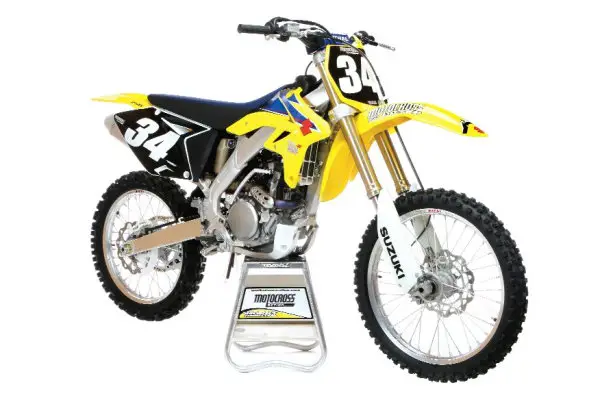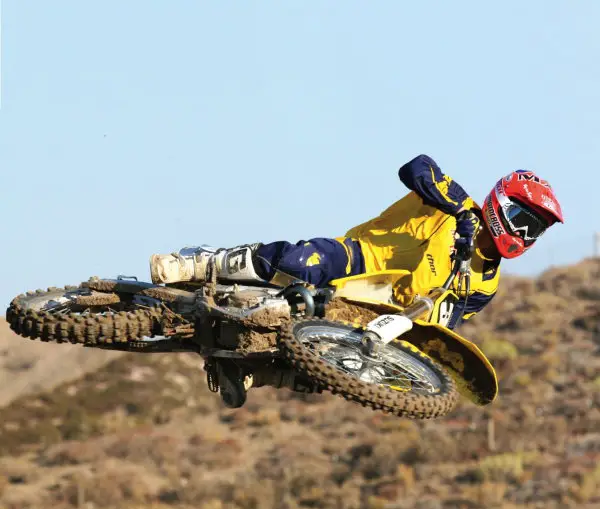MXA RACE TEST: The New 2009 Suzuki’s RM-Z250; Suspension Settings, Jetting Specs, Likes & Dislikes, Plus Much More
INSIDE TEST OF THE 2009 SUZUKI RM-Z250

For a bike that is celebrating its fifth birthday, it’s strange that the Suzuki RM-Z250 is only three years old. How can that be? It’s simple. The first real Suzuki RM-Z250 was the 2007 model. Well, technically Suzuki offered their first RM-Z250 in 2004, but, in truth, the 2004, 2005 and 2006 RM-Z’s were built by Kawasaki (as part of the short-lived Suzuki/Kawasaki alliance). In essence, Suzuki private-labeled a yellow version of the KX250F for three years, and it wasn’t until 2007 that Suzuki built its very own 250 four-stroke.
Although factory engineers would love to make tons of modifications to their product with every new model year, it always comes down to the bottom line. Suzuki invested beaucoup money in the development of the original 2007 RM-Z250 (along with a considerable update to it in 2008) and in the fuel-injected RM-Z450 late in 2008. Making matters worse for the bean counters at Suzuki is the fact that the RM-Z450’s teething problems made the 2008 selling season a disaster.
When you add in relatively new bikes, poor sales in 2008 and the need to hit the ground running in 2009, you can understand why this year’s Suzukis are BNG bikes. BNG is a motorcycle industry term that means “Bold New Graphics” and is used to describe new models that only get aesthetic changes. Although the term has negative connotations, it could be the smartest move for Suzuki to make. The 2009 Suzuki RM-Z450 and RM-Z250 are new designs that haven’t had time to grow stale. The MXA wrecking crew entered the test cycle of the 2009 RM-Z250 with an open mind.
Q: WHAT CHANGES DID SUZUKI MAKE TO THE 2009 RM-Z250?
A: There are three changes: (1) Bold new graphics on the radiator shroud. (2) A new seat cover. (3) An all yellow front number plate.
Q: IS THE 2009 RM-Z250 FASTER THAN THE 2008 MODEL?
A: No. For practical purposes, the 2009 RM-Z250 is the 2008 RM-Z250. There are no engine mods of any kind for 2009.
Q: WHAT ARE THE RM-Z250 POWERBAND’S BEST TRAITS?
A: In a head-to-head comparison between the 2009 RM-Z250 and its green, red, blue and orange competitors, the RM-Z250 hasn’t gained any ground in the hierarchy. It didn’t have the best all-around powerband last year and it doesn’t this year. What it does have is a sweet low-to-mid powerband that is fun to ride, very effective on a race track and at its best on the exit of turns.
In a drag race with the rest of the Big Five, the RM-Z250 could win, providing that the drag strip was 75 feet long. Right off the bottom, the Suzuki is awesome. It barks. The immediate urgency of the RM-Z’s willingness to get moving is its greatest trait. It gets off the mark better than any bike made. The power starts low in the rpm range and continues to build through the midrange. Then, it flattens out. The Suzuki powerband is quite deceptive on the top-end, because it keeps revving without producing any additional power. It doesn’t drop off as much as it sneaks away. A smart RM-Z250 rider short shifts in tune with the torque curve more than with the engine rpm.
Q: HOW GOOD IS THE JETTING?
A: To make the best use of its low rpm power, the Suzuki depends on good jetting to run crisply from the initial crack of the throttle. They did a very good job for pump gas at a sea-level elevation. Here are the stock 2009 RM-Z250 jetting specs:
Main Jet: 162
Pilot Jet: 42
Needle: NLCT-3
Leak Jet: 40
Fuel screw: 1-1/2 turns out
Note: In 2007, the RM-Z came with a 45 pilot, but the change to a 42 helped liven up the throttle response.

Q: HOW DOES THE 2009 SUZUKI RM-Z250’S CHASSIS HANDLE?
A: Like a slot car. Every MXA test rider loves the way the RM-Z250 turns. It takes minimal control input to initiate turns, and the RM-Z250 never misses a line. It is accurate, quick and on rails. Whether it is in ruts, berms or flat turns, the RM-Z250 eats them up. The only caveat to the RM-Z250’s handling is that it is very sensitive to race sag and fork height settings. Often an MXA test rider would complain about oversteer on the RM-Z250, and a cursory check of the race sag would reveal that it was 5mm too high (or that the fork legs were 2mm too low). As a rule, most MXA test riders altered fork height to suit the track conditions: the forks up in the clamps on Supercross-style tracks and the forks down on fast outdoor layouts.
Q: DOES THE ULTRA-QUICK SUZUKI RM-Z250 STEERING GEOMETRY COMPROMISE HIGH-SPEED STABILITY?
A: You have to give to get, but of all the razor sharp bikes that MXA has ever tested, the RM-Z250 has managed to find the best compromise between knifelike handling and high-speed stability. Yes, the Suzuki RM-Z250 does get a little busy on fast, rough straights, but it would be foolish for Suzuki to diminish its greatest strength (cornering) for a touch more stability.
Q: HOW GOOD IS THE SHOWA SUSPENSION?
A: Almost great. What does that mean? Off the showroom floor, the forks and shock are perfectly balanced and the action of the suspension is good. So, what’s the catch? It quickly becomes obvious that Suzuki targeted the RM-Z250’s suspension to minicycle transplants and the Ethiopian national team. If you weigh 140 pounds, the RM-Z250 will be perfect for you. If, however, you are fully grown or faster than Novice speed, the suspension will bottom and bang like a lawnmower with a broken blade.
Buy a scale before you buy an RM-Z250. If you top 150 pounds, you will need to buy stiffer fork and shock springs.
Q: WHAT ARE MXA’S RECOMMENDED SUZUKI RM-Z250 FORK SETTINGS?
A: Here is what the MXA wrecking crew ran in its 2008 RM-Z250 for hardcore racing:
Spring rate: 0.46 kg/mm (0.44 stock)
Oil height: 370cc
Compression: Ten clicks out
Rebound: 12 clicks out
Fork leg height: 2mm up
Notes: Stiffer springs are a must for most riders. Additionally, the forks are sensitive to fork height adjustments. Even a minor fork height change will alter the handling.
Q: WHAT IS MXA’S RECOMMENDED RM-Z250 SHOCK SETTING?
A: Here is what the MXA wrecking crew ran in its 2008 RM-Z250 for hardcore racing:
Spring rate: 5.6 kg/mm (5.4 stock)
Race sag: 100mm
High-compression: Two turns out
Low-compression: Eight clicks out
Rebound: Eight clicks out
Notes: Use the high-speed compression adjuster to control the attitude of the bike in motion. Turning the high-speed adjuster in will keep the rear higher and the bike level at speed. Adjust the high-speed compression with 1/8 turn increments. A small turn makes a very big adjustment.

Q: WHAT HOP-UP PARTS DOES THE RM-Z250 BENEFIT?FROM?
A: Here are the areas where the 2009 RM-Z250 needs the most help.
Fork and shock springs: We swapped the stock 0.44 kg/mm springs for 0.46s and the stock 5.4 kg/mm shock spring for a 5.6. Amazingly enough, even this spring upgrade will not be stiff enough for Pro-level riders (or chunky riders).
Exhaust system: Suzuki owns the low-to-mid part of the powerband, but to go mano-y-mano against bikes that focus on mid-and-up power, the RM-Z250 needs more top end. That can be achieved with aftermarket exhaust pipes. Ryan Dungey runs a Pro Circuit pipe on his RM-Z250, and it does a good job of beefing up the upper end hook.
Gearing: Before you spend money on expensive engine mods, consider gearing the RM-Z250 down by one tooth. Although it magnifies the snap in first gear a little, what it really does is close up the gap between second and third to allow a racer to get into the more effective and longer pulling gear ratios sooner. On a low-to-mid engine it is important to get to the tallest gear possible as soon as possible. If you swap the stock 12/48 combo for a 12/49, you can use second gear in every tight turn and third in the fast ones.
Q: HOW MUCH DOES IT COST?
A: $6299. For comparison, the suggested retail price of the YZ250F is $6599, KX250F $6499, KTM 250SXF $7198 and CRF250 $6549.
Q: WHAT DID WE HATE?
A: The hate list:
(1) Spring rates. If you’ve already hit puberty, you probably need stiffer suspension for your RM-Z250. The stock springs feel like they came out of an old mattress. Either invest in some proper springs or go on a diet.
(2) Gearing. Add one tooth.
(3) Clutch. Luckily, you don’t need to slip the RM-Z250 clutch to get the rpm into the sweet spot, because the sweet spot is on the bottom. It’s a good thing because the Suzuki’s clutch won’t stand up to much abuse.
(4) Bolts. What’s with the RM-Z’s bolts? A standard-sized 8mm T-handle wants to slip on every Suzuki bolt. Suzuki needs to invest in better hardware.
Q: WHAT DID WE LIKE?
A: The like list:
(1) Handling. It is the lifelong ambition of every motocross racer to drag his handlebars through a berm. The Suzuki RM-Z250 is the bike that can make that happen.
(2) Hot start. It seems that every other manufacturer puts their hot start trigger on top of the clutch lever where it takes the maximum abuse in a crash. Suzuki, to their credit, protects their hot start behind the throttle. However, we have broken a lot of Suzuki hot start levers because they are made out of fragile plastic.
(3) Powerband. Despite our complaints about the RM-Z250’s lack of top end, we love this engine. The quick response off the bottom compliments the light feel and precise handling of the bike. What it lacks in sheer power and rev, it makes up in quickness and grunt.
(4) Brakes. The RM-Z’s brakes have a nice feel and good power. We would like a more adjustable rear brake pedal.
Q: WHAT DO WE REALLY THINK?
A: This isn’t a bike for a rider looking for the most horsepower, highest rev or most bells-and-whistles. It isn’t going to jump to the top of the 2009 MXA 250 Shootout by virtue of its yellow front number plate. It is at best going to finish fourth or fifth in every shootout this year. But, don’t believe it! The RM-Z250 has tremendous potential to be much better than it is as it rolls off the assembly line. And even if you didn’t make any more changes than gearing, pipe and springs, this bike is the most fun to ride of any bike the MXA wrecking crew has tested in the last five years.
Read the 2009 250F Shootout now





Comments are closed.